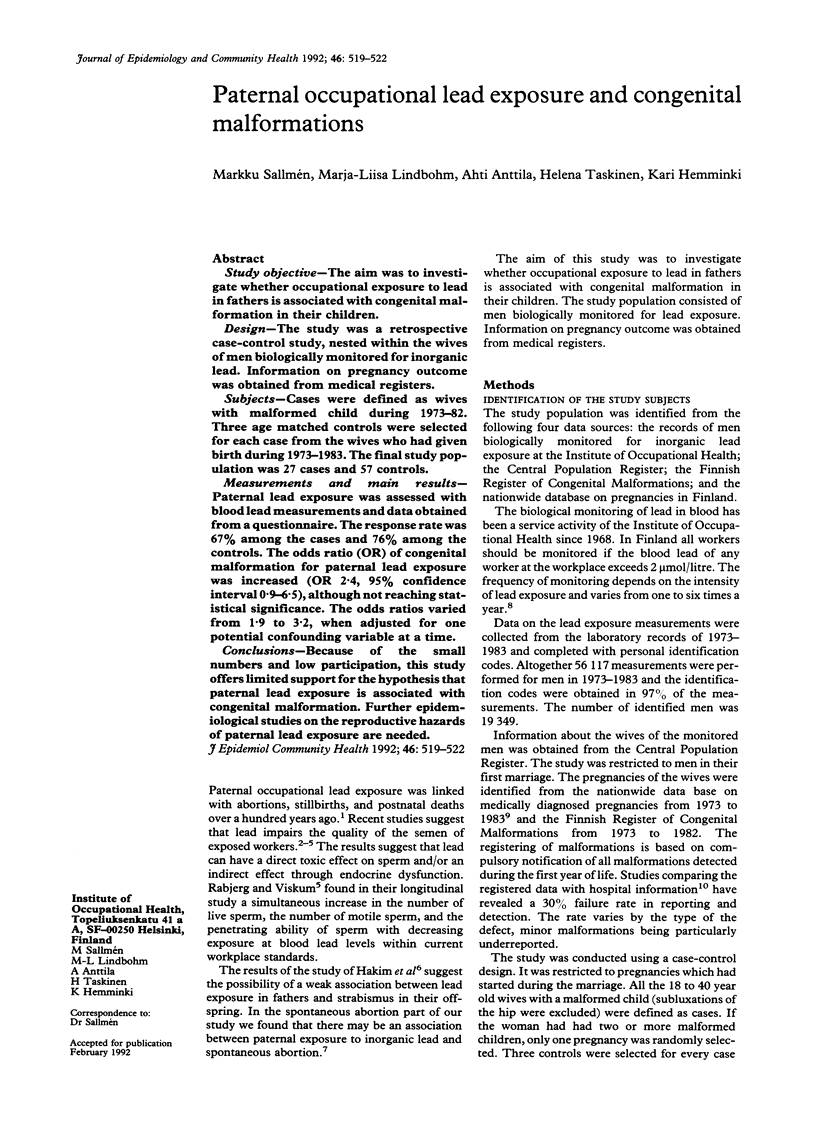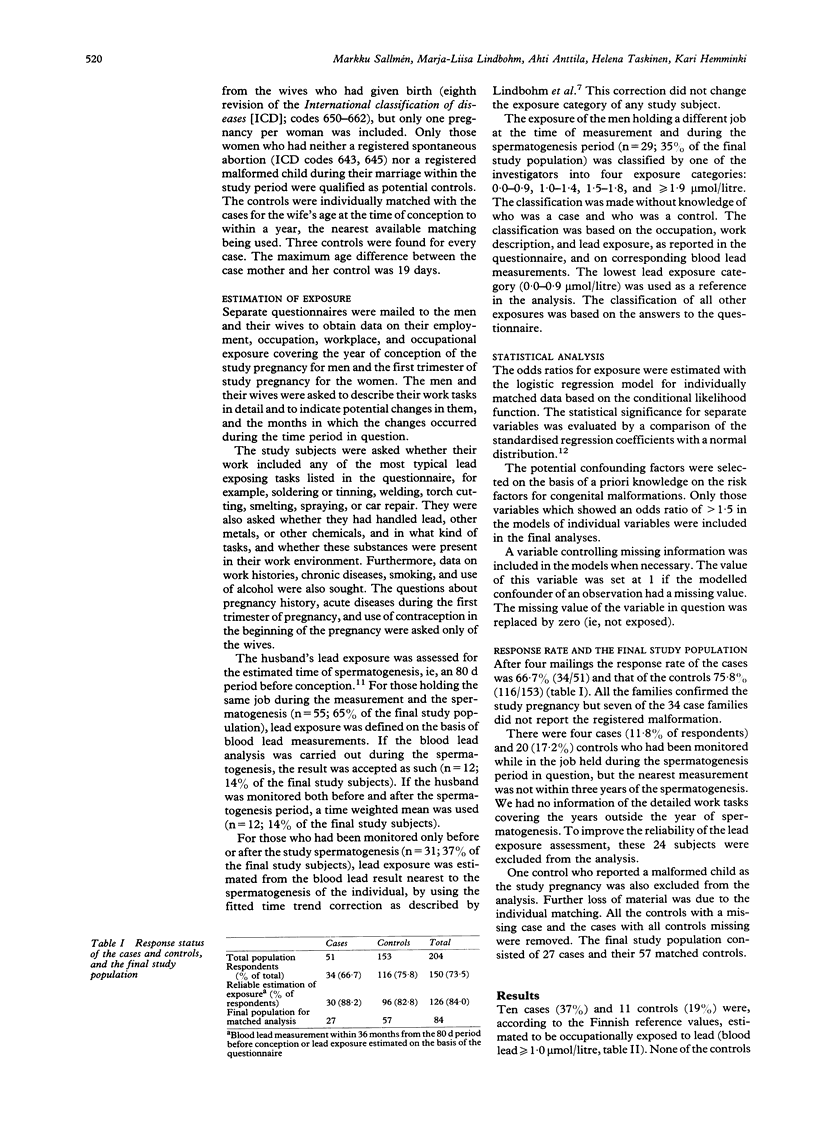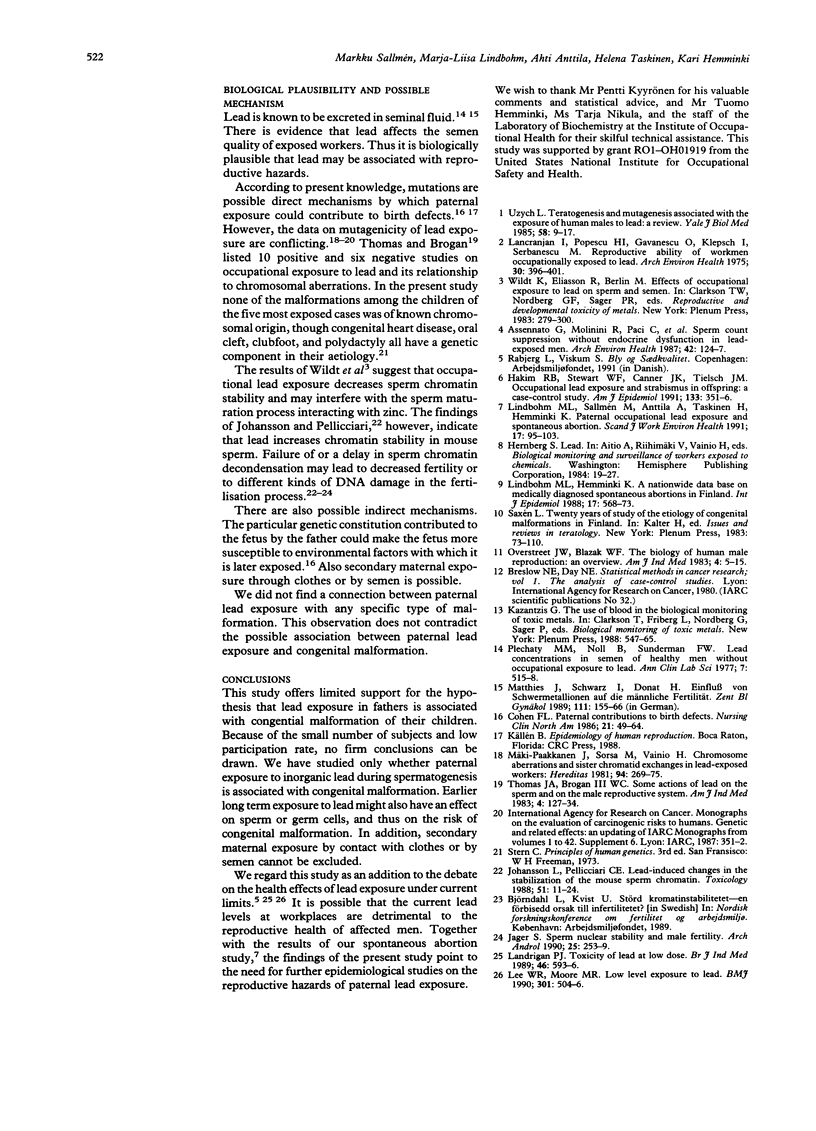Abstract
STUDY OBJECTIVE--The aim was to investigate whether occupational exposure to lead in fathers is associated with congenital malformation in their children. DESIGN--The study was a retrospective case-control study, nested within the wives of men biologically monitored for inorganic lead. Information on pregnancy outcome was obtained from medical registers. SUBJECTS--Cases were defined as wives with malformed child during 1973-82. Three age matched controls were selected for each case from the wives who had given birth during 1973-1983. The final study population was 27 cases and 57 controls. MEASUREMENTS AND MAIN RESULTS--Paternal lead exposure was assessed with blood lead measurements and data obtained from a questionnaire. The response rate was 67% among the cases and 76% among the controls. The odds ratio (OR) of congenital malformation for paternal lead exposure was increased (OR 2.4, 95% confidence interval 0.9-6.5), although not reaching statistical significance. The odds ratios varied from 1.9 to 3.2, when adjusted for one potential confounding variable at a time. CONCLUSIONS--Because of the small numbers and low participation, this study offers limited support for the hypothesis that paternal lead exposure is associated with congenital malformation. Further epidemiological studies on the reproductive hazards of paternal lead exposure are needed.
Full text
PDF



Selected References
These references are in PubMed. This may not be the complete list of references from this article.
- Assennato G., Paci C., Baser M. E., Molinini R., Candela R. G., Altamura B. M., Giorgino R. Sperm count suppression without endocrine dysfunction in lead-exposed men. Arch Environ Health. 1987 Mar-Apr;42(2):124–127. doi: 10.1080/00039896.1987.9935808. [DOI] [PubMed] [Google Scholar]
- Cohen F. L. Paternal contributions to birth defects. Nurs Clin North Am. 1986 Mar;21(1):49–64. [PubMed] [Google Scholar]
- Hakim R. B., Stewart W. F., Canner J. K., Tielsch J. M. Occupational lead exposure and strabismus in offspring: a case-control study. Am J Epidemiol. 1991 Feb 15;133(4):351–356. doi: 10.1093/oxfordjournals.aje.a115888. [DOI] [PubMed] [Google Scholar]
- Jager S. Sperm nuclear stability and male infertility. Arch Androl. 1990;25(3):253–259. doi: 10.3109/01485019008987614. [DOI] [PubMed] [Google Scholar]
- Johansson L., Pellicciari C. E. Lead-induced changes in the stabilization of the mouse sperm chromatin. Toxicology. 1988 Sep;51(1):11–24. doi: 10.1016/0300-483x(88)90076-5. [DOI] [PubMed] [Google Scholar]
- Lancranjan I., Popescu H. I., GAvănescu O., Klepsch I., Serbănescu M. Reproductive ability of workmen occupationally exposed to lead. Arch Environ Health. 1975 Aug;30(8):396–401. doi: 10.1080/00039896.1975.10666733. [DOI] [PubMed] [Google Scholar]
- Landrigan P. J. Toxicity of lead at low dose. Br J Ind Med. 1989 Sep;46(9):593–596. doi: 10.1136/oem.46.9.593. [DOI] [PMC free article] [PubMed] [Google Scholar]
- Lee W. R., Moore M. R. Low level exposure to lead. BMJ. 1990 Sep 15;301(6751):504–506. doi: 10.1136/bmj.301.6751.504. [DOI] [PMC free article] [PubMed] [Google Scholar]
- Lindbohm M. L., Hemminki K. Nationwide data base on medically diagnosed spontaneous abortions in Finland. Int J Epidemiol. 1988 Sep;17(3):568–573. doi: 10.1093/ije/17.3.568. [DOI] [PubMed] [Google Scholar]
- Lindbohm M. L., Sallmén M., Anttila A., Taskinen H., Hemminki K. Paternal occupational lead exposure and spontaneous abortion. Scand J Work Environ Health. 1991 Apr;17(2):95–103. doi: 10.5271/sjweh.1721. [DOI] [PubMed] [Google Scholar]
- Matthies J., Schwarz I., Donat H. Einfluss von Schwermetallionen auf die männliche Fertilität. Zentralbl Gynakol. 1989;111(3):155–166. [PubMed] [Google Scholar]
- Mäki-Paakkanen J., Sorsa M., Vainio H. Chromosome aberrations and sister chromatid exchanges in lead-exposed workers. Hereditas. 1981;94(2):269–275. doi: 10.1111/j.1601-5223.1981.tb01764.x. [DOI] [PubMed] [Google Scholar]
- Overstreet J. W., Blazak W. F. The biology of human male reproduction: an overview. Am J Ind Med. 1983;4(1-2):5–15. [PubMed] [Google Scholar]
- Plechaty M. M., Noll B., Sunderman F. W., Jr Lead concentrations in semen of healthy men without occupational exposure to lead. Ann Clin Lab Sci. 1977 Nov-Dec;7(6):515–518. [PubMed] [Google Scholar]
- Thomas J. A., Brogan W. C., 3rd Some actions of lead on the sperm and on the male reproductive system. Am J Ind Med. 1983;4(1-2):127–134. [PubMed] [Google Scholar]
- Uzych L. Teratogenesis and mutagenesis associated with the exposure of human males to lead: a review. Yale J Biol Med. 1985 Jan-Feb;58(1):9–17. [PMC free article] [PubMed] [Google Scholar]


